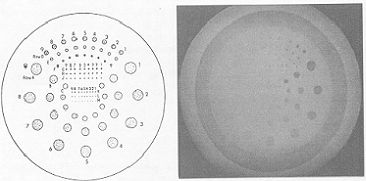

The actual field size can be calculated by the number of squares seen, the source-
to-object distance and the source-to-I.I. distance. The ‘S’ distortion can be
assessed by visual inspection of the image. The geometric distortion can be
quantified by measuring the diagonals of the central square, and of the largest
square in the field.
(f)
Overall imaging performance:
A test object, consisting of a perspex plate on which metal discs in a range of
thickness and diameters, is used. Under calibrated x-ray beam conditions, the
object produces calibrated contrasts for the various discs.
The overall performance can be assessed by counting the number of discs
visible for each group.
1.3 Maintenance of X-ray equipment
Responsibility for maintenance of X-ray equipment may lie with the
manufacturer, or medical physics services or both. The physicist is therefore
prepared to contribute to regular maintenance, usually in an advisory or
administrative capacity. Responsibility is also taken for ensuring that the
appropriate standards of electrical and mechanical safety are maintained.
1.4 Regular monitoring of equipment
Regular monitoring of equipment, including retake and reject analysis, is
necessary to ensure effective operation and image quality. This aspect of quality
assurance is undertaken in conjunction with other professions, notably the
radiographer. Some of the tests performed in acceptance of the equipment may be
repeated to make sure there is no significant deterioration in its performance.
2.
Radiation protection
Radiation protection duties involve the measurement and control of doses to patients,
staff and member of the general public.
2.1 Protection of the patient